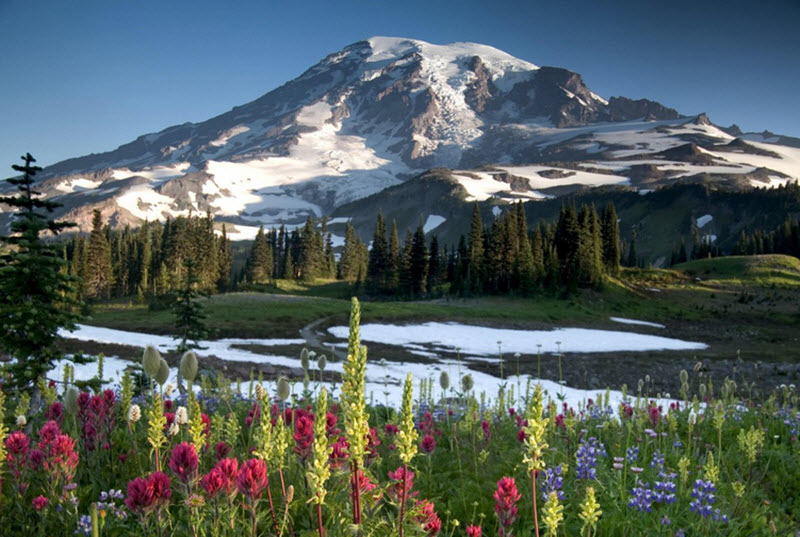The Olympic National Park is located on the Olympic Peninsula in the western part of Washington State. The Olympic Peninsula is an arm of land the stretch

es out into the Puget Sound, bordered to the west by the Pacific Ocean.
The Olympic National Park is one of very few spots in the continental United States where you can visit a rainforest. This national park is also home to somewhat drier forests (on the east side), alpine areas, wildflower meadows, and the rugged environments along the Pacific coast. Roughly 366,000 acres (1,480 square km) are covered in old-growth forests.
Examples of animals that live in the park are black bear, cougar, black-tailed deer and Roosevelt elk. Since this peninsula is fairly closed off in some regards, we can find plenty of endemic species that only exist here. There is for instance the Olympic marmot, Flett’s violet and Piper’s bellflower.
The area was designated a National Monument in 1909, National Park in 1938, UNESCO International Biosphere Reserve in 1976, and World Heritage Site in 1981.
Where is it?
| State | Washington State, USA |
| Coordinates | 47°58′10″N 123°29′55″W |
| Counties | Clallam County
Grays Harbor County Jefferson County Mason County |
| Nearest city | Port Angeles |
The coastal areas
The 60 mile coast within the park contains both sandy beaches and shorelines covered in heavy rocks and large boulders. Driftwood is often stranded here. As the two rivers Hoh and Quileute empty themselves in the Pacific Ocean, they discharge large amounts of naturally eroded timber.
The most frequently visited part of the coast is the 9-mile (14 km) Ozette Loop. It consists of three miles of boardwalk-enhanced path through a coastal ceder swamp, three miles along the ocean (supplemented by headland trails when the tide is high) and three more miles of boardwalk-enhanced trail.
The park is renowned for its exposed turbidites with calcite veins. Turbidites are rocks or sediments that travel into the sea as suspended particles, before forming a sedimentary layering on the sea floor.
Glaciers
Massive glaciers are found on the sides and ridgelines of the Olympic Mountains. The western half of the mountain range is dominated by the peak of Mount Olympus, where the summit it 2,428 metres above sea level. Mount Olympus, which recieves a lot of snow every winer season, is home to several glaciers, of which the largest one is the Hoh Glacier. This glacier is over 3 miles (nearly 5 km) in length.
Rainforest
The famous temperate rainforests are found on the western side of the park, which recieves huge amounts of rain each year. The Hoh Rainforest and the Quinault Rainforest both get around 150 inches (380 cm) of precipitation in an averge year, making this one of the wettest spots in the country.
When we hear the word rainforest, we often think about the tropical rainforest with its warm-weather species, but the rainforests in this park are temperate rainforests dominated by coniferous trees that are good at handling cold. Western hemlock, Coast Douglas fir, Sitka Spruce, and Western Red cedar are all common species here.